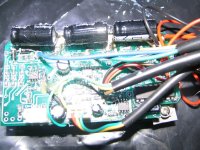The7 said:
V2 = Vbattery x D ( D is the %age duty cycle)
I2 = I1 / D
Hope this could give you some help.
Yes, thanks much.
Does anyone know if a recently purchased ebikes/Crystalyte 72v, 20a, 4110 fets, pedal first controller can be converted to instant start ?
IE, is it just a matter of missing/changed/added components, or is it a completely different board ? (Getting tired of pedal first, but it seemed the best controller to get for my needs, other than PF.)
EDIT3: Problem is now intermittent. Ebikes Justin replied that it may be capacitor inrush current and I think he's right. This happened after I re-upgraded from 40v to 80v, so inrush current is higher. My 80v config previously had a resistor and a pre-charge switch to limit initial current, which I added after watching a 5 second light show (which welded the switch on) inside one of my 120vac 15a light switches I use for battery management. Guess I'll have to add this again, or perhaps an inductor or some other form of surge suppression.
EDIT2: My controller inexplicably started working again. Go figure. I can't imagine a wiring issue that would cause this. All wires to controller look fine.
EDIT: My 3 week old controller is now appearing dead. Last night it worked fine, and it's been flawless until now. Today, it trips my BMS, which requires 31a to trip. If I disconnect the motor, LED lights solid and BMS is fine. SOMETIMES, the LED also indicates fine with motor connected, but as soon as I go to PF, it doesn't start and BMS trips.
I've never (yet) opened or modified anything. I'm running at 40 volts or so now, so I don't think voltage was an issue. Previously I ran it at up to 83.9 volts (warranty good until 84

)at full 20 amp throttle up some 3-5 minute hills and it was fine then too,
Diode test on all 3 wires that go to motor indicates no shorts. about 0.3v or so drop (?) on eAch in one direction
Happened out of blue; no magic smoke or noise etc; hoping there is a secret hidden reset switch

Any ideas or trouble-shooting tips ?
Thanks !


